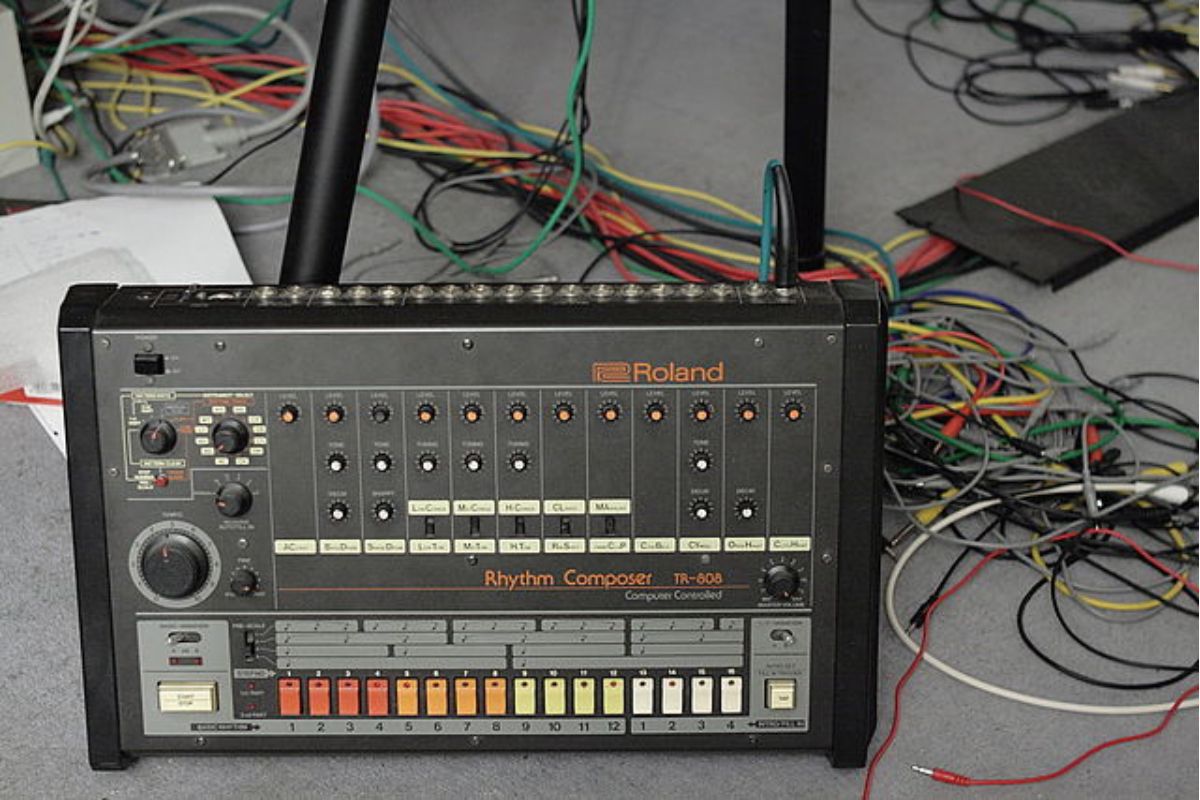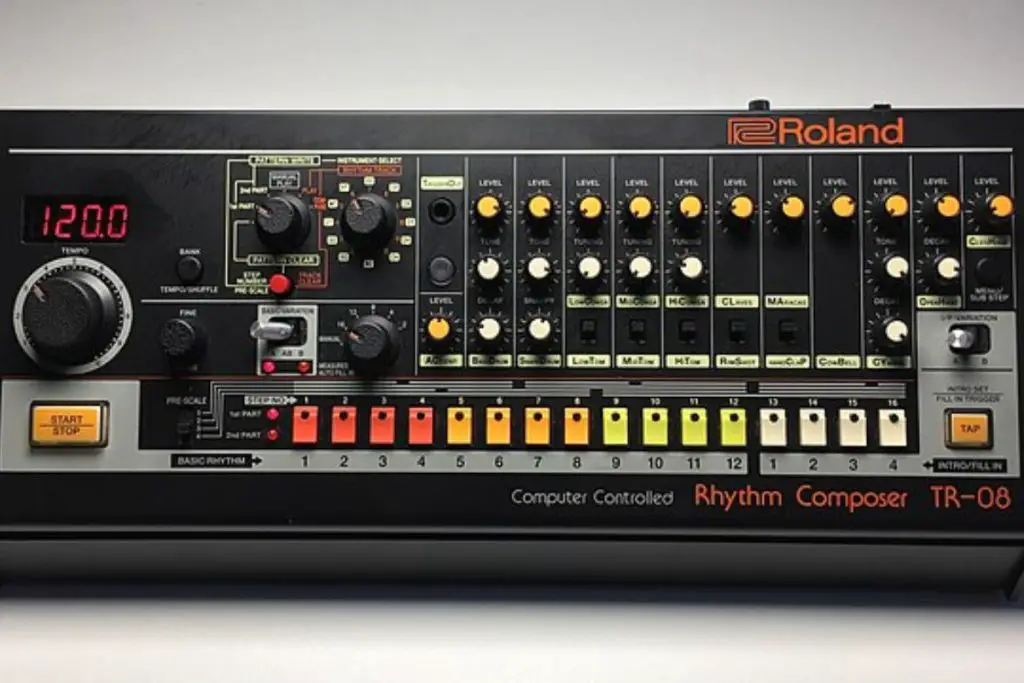Are you ready to dive into music production and unlock the secrets behind those mesmerizing 808s? Get ready to unleash the power of the iconic Roland TR-808 drum machine and create earth-shaking beats that make heads nod, and speakers rumble.
So, what exactly is an 808? Originating from the legendary Roland TR-808 drum machine, the 808 is a sub-bass sound synonymous with trap and electronic music. Its distinct character and versatility have made it an essential ingredient in modern music production.
What is an 808?
The 808 is a sub-bass sound originating from the iconic Roland TR-808 drum machine. A deep, rumbling bass hits you right in the chest and makes you feel like you’re standing in the middle of a club with the speakers on full blast. Yeah, that’s the 808.

But what makes the 808 so special? It’s not just any ordinary bass sound. The 808 has a unique sonic character shaping the music landscape for decades. From trap to electronic music, the 808 has become a staple in modern productions, providing that low-end foundation and adding a dose of undeniable groove.
The 808 sound is characterized by its subby-ness, which means it has an intense low-frequency presence that can be felt as much as it’s heard.
You might wonder, “Why is the 808 so widely used and loved?” The answer lies in its unmistakable sonic qualities. The 808 sound is characterized by its subby-ness, which means it has an intense low-frequency presence that can be felt as much as it’s heard. It’s like the bass equivalent of a thunderstorm, commanding attention and impacting your tracks.
The 808 is also incredibly versatile. You can tweak and tune it to different pitches, allowing you to create melodic basslines or thunderous kicks that hit harder than a heavyweight boxer.
AKAI Professional MPK Mini MK3

AKAI Professional MPK Mini MK3
Where does TR-808 originate from?
Curious about the origins of the TR-808? Let’s dive into its fascinating backstory. In the early 1980s, when shoulder pads and neon colors were all the rage, Roland introduced the now-legendary TR-808 drum machine. But here’s the twist: the 808 didn’t initially find mainstream success.
The Underdog Triumphs
While the 808 might not have been an instant hit, underground music genres like techno, house, and hip-hop recognized its potential. These genres embraced the distinct sounds of the TR-808, defying the conventional norms of popular music. The 808’s rebellious spirit and futuristic sonic palette sparked a revolution, challenging traditional drum sounds and giving birth to new musical movements.
Influence
The impact of the TR-808 cannot be overstated. From the deep grooves of Chicago house to the infectious beats of Miami bass, the 808’s influence spread like wildfire across genres and continents. Techno pioneers, hip-hop legends, and dance music fans all recognized the transformative power of the 808 sound. Its unmistakable kick drum and earth-shaking bass became synonymous with musical innovation.
But the 808 didn’t stop there. It infiltrated pop music, infusing chart-topping hits with its infectious rhythms. From the iconic “Planet Rock” by Afrika Bambaataa & The Soulsonic Force to modern trap anthems, the TR-808 continues to leave its sonic fingerprints on countless tracks.
The TR-808 was more than just a drum machine; it represented a paradigm shift in music production. It challenged conventional notions of what drum sounds should be and opened up new avenues for creativity. Today, the 808 remains an essential tool for producers and artists worldwide, continuing to push boundaries and redefine the sonic landscape.
Dos and Don’ts of Using the TR-808
Ready to harness the power of the TR-808 in your music? Here’s a handy table to guide you on the path to 808 greatness:
| Dos | Don’ts |
|---|---|
| Experiment with different 808 sounds and textures | Rely solely on the default 808 settings |
| Use the 808 to add depth and impact to your tracks | Overuse the 808, overpowering other elements |
| Tweak and customize the 808 to fit your style | Neglect proper EQ and mixing to control low-end issues |
| Incorporate the 808 creatively in various genres | Limit yourself to using the 808 in a single context |
| Learn from the classics but strive for innovation | Replicate other artists’ sounds without adding your own twist |

How to make great 808s
Now that we’ve covered the basics, it’s time to level up your 808 games and make those basslines shine.
1. Starting with a solid foundation
To create great 808s, begin with a good sample. A well-crafted sample sets the stage for everything that follows. Look for samples that resonate with your vision and style, ensuring they align with the genre and mood of your track. Remember, the right sample can make all the difference.
2. Tuning
Tuning your 808 is essential for achieving that perfect harmonic relationship with your track. Experiment with different pitches to find the sweet spot that complements your melodies and adds depth to your composition. Don’t be afraid to explore different tonalities beyond the default setting and explore different tonalities.
3. EQing
Next up, we have EQing. To make your 808s shine, focus on the bottom end of the mix. Use an EQ to sculpt the sub-frequencies, ensuring they sit well with the other elements of your track. Be mindful of clashing frequencies and precisely adjust to strike the perfect balance.
4. Sound designing your sample
One way to take your 808 games to the next level is by sound designing your sample. This allows you to craft a unique sound that perfectly matches your artistic vision. Experiment with synthesis techniques, layering, and processing to create 808s that are truly one-of-a-kind.
You can also incorporate distortion, saturation, and other effects to add character and warmth to your 808s. Don’t be afraid to push the boundaries and experiment with unconventional techniques. Remember, the goal is to create basslines that leave a lasting impression on your listeners.
Advantages and disadvantages of using TR-808
When harnessing the power of the 808 in your music production, it’s important to consider both the advantages and disadvantages. Let’s explore some of the key aspects.
Advantages
The 808 offers a range of advantages that make it an irresistible tool for music producers:
- Iconic Sound: The 808 sound is instantly recognizable and carries a rich legacy in various genres, adding a sense of familiarity and authenticity to your tracks.
- Versatility: From deep sub-bass lines to punchy kicks, the 808 is highly versatile, allowing you to shape its sound to a wide range of musical styles.
- Groove and Impact: The 808 brings a captivating groove and an undeniable impact to your music, making it impossible for listeners to resist moving to the beat.
- Creative Freedom: Sound designing your own 808 samples allows for unparalleled creativity and the ability to craft unique sounds that define your style.
- Genre Influence: Incorporating the 808 in your productions can help you tap into the influence of genres like trap, hip-hop, and electronic music, enabling you to create music that resonates with current trends.
Disadvantages
While the 808 has its fair share of advantages, it’s important to be aware of a few potential drawbacks:
- Overuse: Due to its popularity, the 808 sound has become quite pervasive in modern music. Overusing it without adding your own creative touch may result in your tracks sounding generic or lacking originality.
- Mixing Challenges: The power of the 808 comes with its own set of mixing considerations. Balancing the low-end frequencies and avoiding conflicts with other elements in the mix can be a technical challenge.
- Sonic Dominance: In some cases, the 808’s strong presence can overpower other elements in your track. It’s crucial to find the right balance and ensure that other musical components receive adequate attention.
If you want even more great tips and information, check out the video below.
Frequently Asked Questions (FAQ)
Can I use the 808 sound in genres other than hip-hop and electronic music?
Absolutely! While the 808 has deep roots in hip hop and electronic genres, its versatility allows it to shine in various musical styles. Experiment with the 808 in genres like pop, rock, R&B, and even experimental music to add a unique sonic flavor to your compositions.
Do I need expensive gear to create great 808s?
Not at all! While high-end gear can certainly enhance your production workflow, you don’t need to break the bank to make killer 808s. Many software synthesizers, plugins, and sample libraries offer affordable and high-quality options for creating powerful bass sounds. Focus on honing your skills and exploring the creative possibilities within your budget.
How can I make my 808s stand out and sound unique?
To make your 808s stand out, consider experimenting with the following techniques:
Layering: Combine multiple 808 samples or synths to create a rich and complex sound.
Processing: Apply creative effects like modulation, distortion, and saturation to add character and texture.
Creative Pitch Modulation: Experiment with pitch bends, glides, and automation to create interesting melodic patterns and movement.
Sound Design: Design your own 808 samples using synthesis techniques, shaping the waveform, and adding custom effects.
Unconventional Rhythms: Play with rhythm variations and syncopation to bring an exciting and unexpected element to your basslines.
Conclusion
We’ve journeyed through the fascinating realm of the Roland TR-808, unraveling its origins, exploring its sonic influence, and discovering ways to make your 808s shine. It’s safe to say that the 808 has become a true legend in the music production world—always ready to deliver those earth-shaking basslines that keep the crowds moving.
So, whether you’re crafting trap beats that hit harder than a meteor shower or exploring new sonic territories with experimental electronic sounds, remember that the 808 is your trusty companion, offering endless creative possibilities. Embrace its power, unleash your creativity, and let the music speak volumes.
If you have any questions or want to share your thoughts, drop a comment below (I read and reply to every comment). Don’t forget to share this article with your fellow music producers and explore the full blog for more tips and tricks on conquering the world of music production. Keep rocking those beats, and until next time, happy producing!
Key Takeaways
This article covered the iconic Roland TR-808 and its profound impact on modern music production. Here are some key takeaways:
- The 808 is a sub-bass sound originating from the Roland TR-808 drum machine, characterized by its unique subby-ness and tunability to different pitches.
- The TR-808 revolutionized genres like techno, house, and hip-hop, shaping the music landscape and leaving a lasting influence.
- To create great 808s, start with a good sample, tune and EQ the sound, and consider sound designing your own samples for added creativity.
- The 808 offers advantages such as its iconic sound, versatility, and genre influence, but it requires careful mixing and avoiding overuse to avoid drawbacks.















